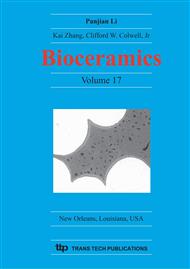p.97
p.101
p.105
p.109
p.113
p.117
p.121
p.125
p.129
The Effects of Calcium Aluminate Cement According to Particle Sizes on Calvarial Bone Defects in Rats
Abstract:
This present study was carried out to find out the effects of calcium aluminate cement(CaO·Al203, CAC), which has been developed with biocompatibility and mechanical properties, in biological environments. Two different particle sizes of CAC - 3.5 µm vs. 212-250 µm which is recommended in periodontal bone grafting procedures – were filled in 8mm calvarial defects in Sprague-Dawley rats. The specimens were examined histologically, especially the bone-cement interface and the response of surrounding tissues. The result of this study shows that when calvarial defects in white rats are filled with 212-250 µm calcium aluminate cement, the materials proved to be bio-compatible in growth and healing on the surrounding tissues. When further researches on direct bone adhesion and bone regeneration ability are fulfilled, CAC is expected to be applied to various fields of periodontology in the future.
Info:
Periodical:
Pages:
113-116
Citation:
Online since:
April 2005
Authors:
Keywords:
Price:
Сopyright:
© 2005 Trans Tech Publications Ltd. All Rights Reserved
Share:
Citation:


